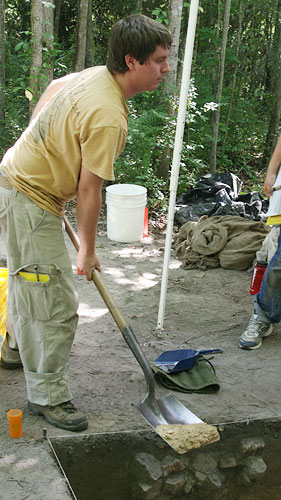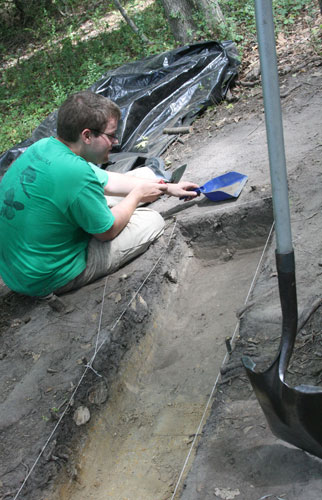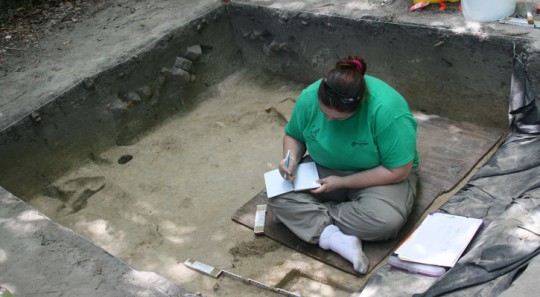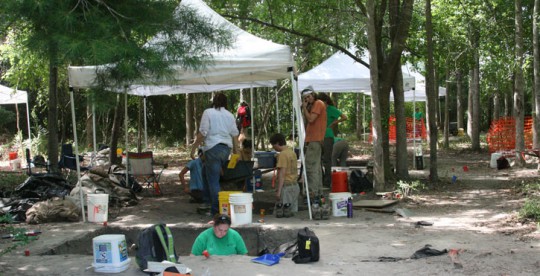UWF Uncovering 1740’s Spanish Mission In Molino
June 24, 2011
A major archaeological dig is underway this summer in Molino, as evidence of a 1700’s mission and even a 6,000 year old artifact have been uncovered.
 “It’s amazing that this is right here in our own backyard,” said undergraduate archaeology major Phillip Mayhair (pictured left), a 2008 Northview High graduate that lives just a few miles away in Barrineau Park. “It was amazing that they found this right here in Molino.”
“It’s amazing that this is right here in our own backyard,” said undergraduate archaeology major Phillip Mayhair (pictured left), a 2008 Northview High graduate that lives just a few miles away in Barrineau Park. “It was amazing that they found this right here in Molino.”
The Mission San Joseph De Escambe was established upriver along the Escambia River — which, along with Escambia County, actually took its name from the mission near Molino. The Apalachee Indian settlement with about 75 residents is well documented, according to archaeologist John Worth. It was established in the 1740’s. A Franciscan missionary was stationed by the Spanish at the village along with 15 members of a Spanish cavalry unit until about 1757.
The village was led by Apalachee Chief Juan Marcos Fant until it was destroyed during a Creek Indian raid on April 9, 1761. The village and the church were at least partially burned during the raid. Following the raid, the residents moved down the Escambia River to what is now downtown Pensacola.
 The Mission was uncovered in 2009 by the UWF archeology students under the leadership of professor of Worth, who spent years digging through historical records before the actual digging in Molino began.
The Mission was uncovered in 2009 by the UWF archeology students under the leadership of professor of Worth, who spent years digging through historical records before the actual digging in Molino began.
Now, the UWF students are digging on a private lot not far from the Molino Boat Ramp and Fairgrounds Park. They are uncovering period artifacts from the Mission, as well as items thousands of years old (like a 6,000 year old spearpoint) and other bits of more modern-era Molino history.
“Clearly, this was the site of the Mission San Joseph De Escambe,” Worth said. “It’s a near pristine site; it’s never been plowed or really disturbed all of these years.”
The Missions settlement is believed to have included a Spanish missionary church and a small Apalachee Indian village.
While the walls have deteriorated over time and appear to the casual observer to be nothing more than darker soil, two summers ago UWF students found almost 40 wrought iron nails in their original positions. In what was called an “amazing” find, students uncovered a wrought iron nail still embedded in piece of wood, the remains of a beam or post where the nail was hammered about 250 years ago.
“So far, we have not found the church,” Worth said. “We would really like to discover it.”
Coming up this weekend on NorthEscambia.com, we’ll take a more in-depth
look at the items found at the archaeological site in Molino.
Editor’s note: The Mission historical site is located on private property and is not accessible to the general public.
Pictured: UWF Students work to uncover the 250-year old Mission San Joseph De Escambe not far from the Escambia River in Molino. NorthEscambia.com photos, click to enlarge.
Comments
7 Responses to “UWF Uncovering 1740’s Spanish Mission In Molino”





Glad to see phillip doing good. He is one of Northviews finest!
I did not know this, I always thought that Cantonment and Gonzalez were the first areas settled, in NWF. I would love to see photos of the Molino area from the 1800s into early 1900s. A photo of the fairgrounds with carnival would be great!
this is great would like to see more and know more about the history of this area like cantonment where jackson camped when he came to fl is there a website i can go to please keep us informed
This is a wonderful find. I know everyone connected with the site is very excited. Wishing them the best of luck. Hope you find some remains of the church. Thanks William for keeping us informed on this project and the other news in our area.
What a wonderful story, it’s a ‘feel good read’. Good Luck.
Very interesting story! Glad to see you out there Phillip! I love all of the history that our community holds Thanks William for the story!
Thanks William for the story!
now the county remodels the old molino school. maybe they can make a museum and put these finding and the steam boats in it.